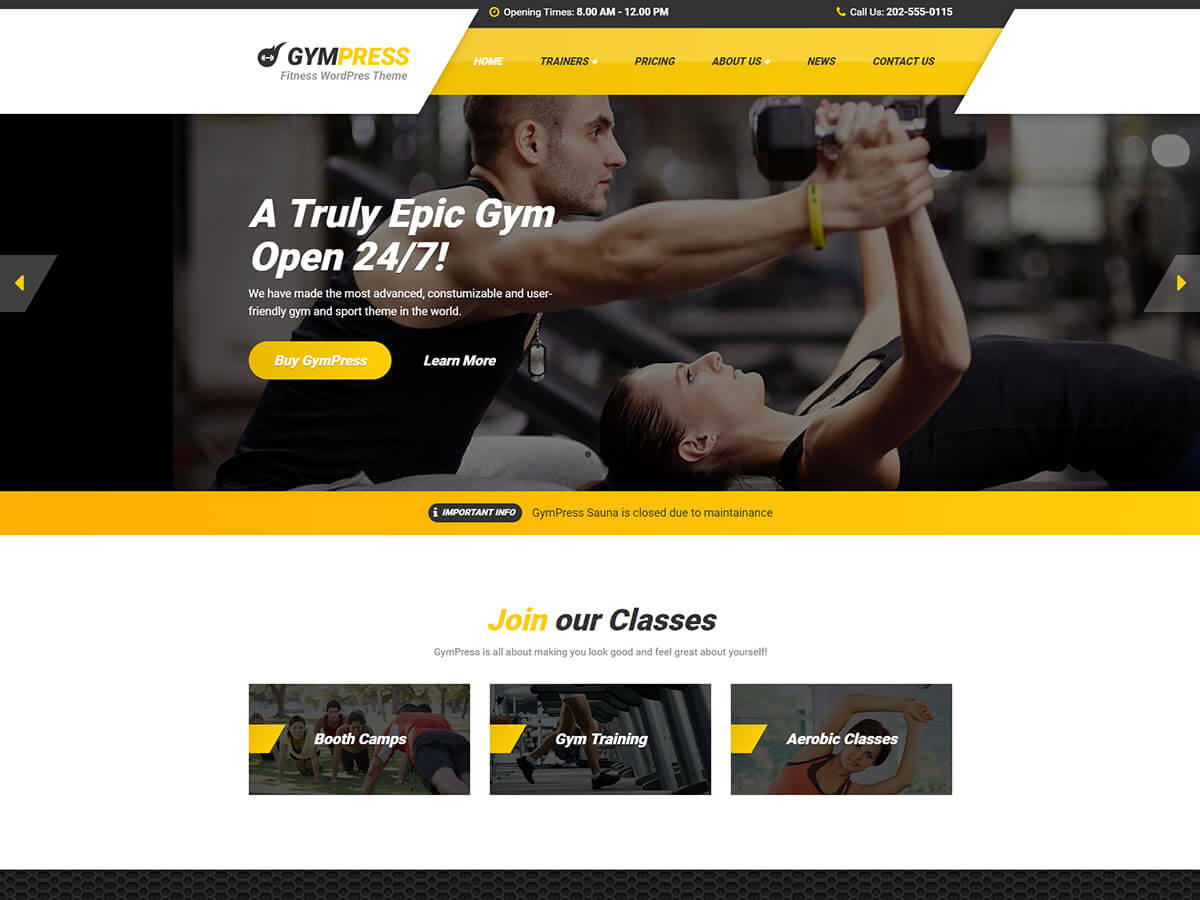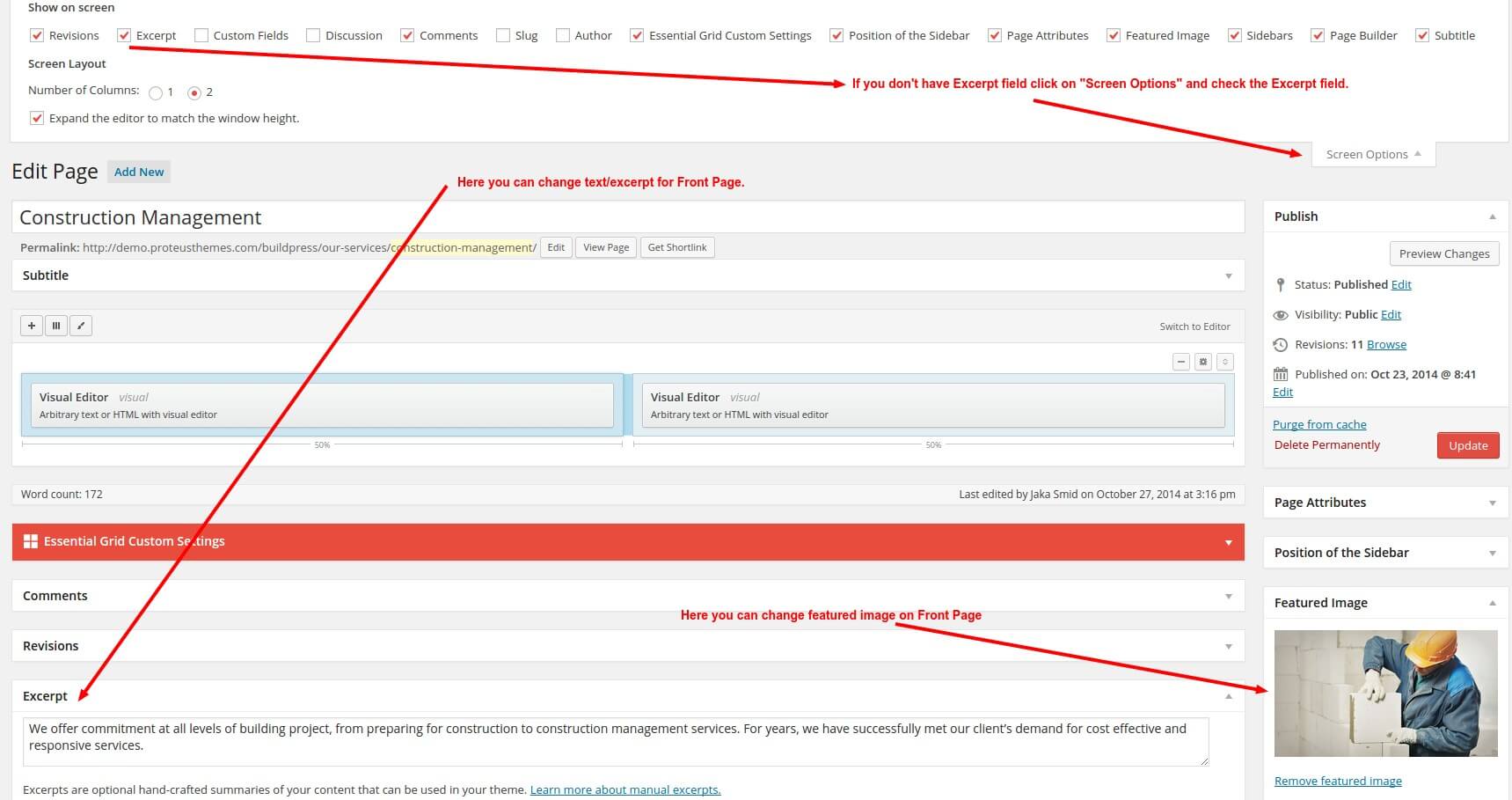Introduction & Installation
Introduction
GymPress is a great WordPress theme for business with focus on sports. It's perfect for a Gym, Fitness or Personal Trainer, but it's also very flexible, so it can be used for other niche sites.
Installation
I assume you already have a fresh copy of WordPress installed on your server.
Download the theme zip file
The first thing you will need to do is to download the theme installation zip file.
If you bought the theme on our ProteusThemes Shop, you should have received an email with the list of themes you have access to. You can click on the theme link with file name ending: -installable.zip or you can login to your account and download the installable zip file from there.
If you bought the theme on ThemeForest, then you have to download the installable WordPress files only zip file from the ThemeForest download section.
Install the theme
You can install the GymPress WP Theme in two different ways:
- Upload a zip file - preferred method
When you are logged in your WordPress dashboard go to Appearance » Themes » Add New » Upload Theme and select the theme installation zip file you downloaded from our Shop or from the ThemeForest and click Install Now button. - FTP upload
Unzip the contents of the theme installation zip file and upload the extracted folder to your server towp-uploads/themes/folder using a FTP client.
Once your theme is on the server, activate it by clicking the Activate button below the preview image in Appearance » Themes
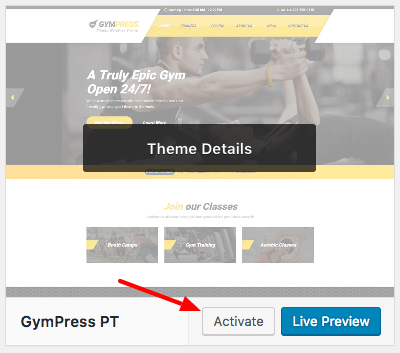
Congratulations! Now the GymPress WP Theme is installed.
Updates
Automatic updates
You can register the theme and receive automatic updates. Go to Appearance » Theme Registration and follow the instructions on that page. This will register your copy of the theme and you will get update notifications in the admin dashboard whenever an update is available.
If you have any issues with the automatic updates, please go to you wp-admin to Dashboard » Updates and click on the Check Again button, to refresh the update data.
Manual update
You can also update the theme manually.
Customize the Appearance
You can fully customize the appearance of the GymPress WP Theme. Go to Appearance » Themes and click on the Customize button:
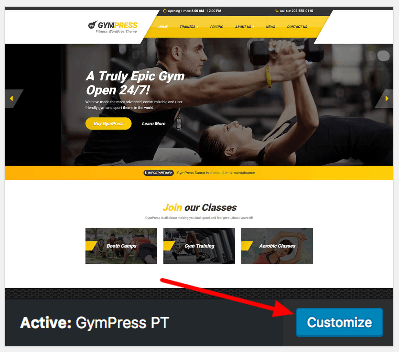
The new window appears and you can now customize the appearance of your theme — upload your custom logo, change the base colors, enable/disable theme features, add custom CSS or JavaScript, etc.
Demo Content
One Click Demo Install
You can import demo content from our demo site (with blurred licensed images) with a single click of a button. Go to Appearance » Import Demo Data and click on the import button.
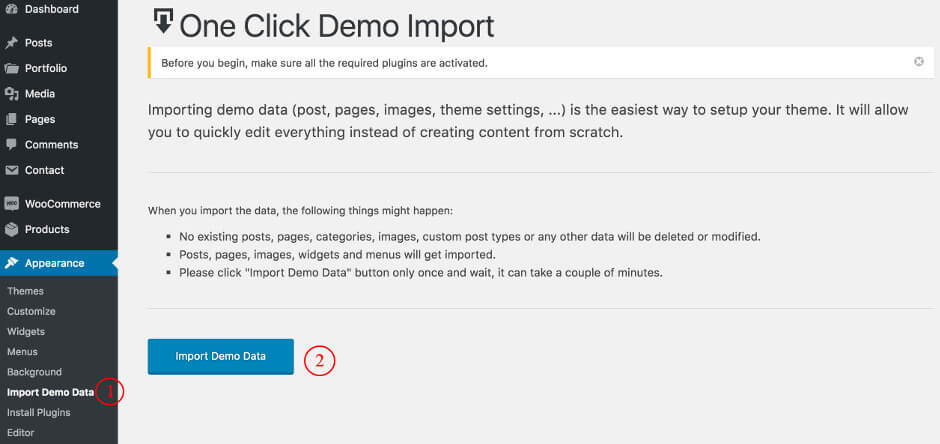
When setting up a content with your new theme, put special focus on the page speed optimization, especially on the image optimization process. This way you can save on your bandwidth, reduce the bounce rate on your website, and make your users happy. Our themes are created with the speed in mind but large, non-optimized images can and will ruin this experience.
Import XML File
If you want to import the demo content the old-fashioned way, you can get a fresh copy of the XML file on our server at this URL: https://artifacts.proteusthemes.com/xml-exports/gympress-latest.xml. Don't forget to activate all required plugins before importing demo data. To import the demo data go to Tools » Import, click on WordPress (install the WordPress Importer plugin if not already installed) and upload/import the previously saved xml file (don't forget to enable the Download and import file attachments checkbox to also import the images).
Demo Widgets
After you import the demo content, you can also import widgets the old-fashioned way. The file for widget import is also located on our server: https://artifacts.proteusthemes.com/json-widgets/gympress.json. Rename this file to gympress.wie (mind the file extension) and use it in the plugin Widget Importer & Exporter. Go to Tools » Widget Import/Export and import the file.
After import setup
After you have imported the demo data and widgets, you should also setup these things:
- go to Settings » Reading, set the the Front page displays to a static page and select the front page and the blog page in the appropriate dropdowns,
- go to Appearance » Menus, select the main menu from the dropdown at the top and click on Select. Scroll to the bottom and set the Theme location to Main Menu (if there are more locations you can also assign other menus to those locations),
- go to Appearance » Widgets, and set Custom menu widgets, by selecting the correct menu (in footer and our services sidebars),
- optionally set other things (like logo, colors, ...). These settings can be found in Appearance » Customize.
If for some reason these URLs are not available:
- and you bought the theme on our ProteusThemes shop, you can login to your account and download the extras zip file, or
- if you bought the theme on Themeforest, you can download the All files & documentation zip from ThemeForest
Once the main theme zip file is downloaded you will find the content.xml and widgets.json file in the extras folder.
Header
Top Bar
In GymPress you will find highly customizable Top Bar area. Both left and right top side are made with widgets which can be added or removed here - Appearance » Widgets » Top Left or Top Right.
Top Bar supported widgets:
- Icon Box
- Social Icons
- Custom Menu
- Text Widget
Logo
The logo can be changed in our Theme Options - Appearance » Customize » Theme Options » Logo.
Favicon
Since WordPress version 4.3, the favicon setting can be found in Appearance » Customize » Site Identity, where you have to set the Site Icon option.
Main Menu
Main Menu can be set in wp-admin » Appearance » Menus. Theme locations for Main Menu is called Main Menu.

Special Dropdown Menu
GymPress is full of useful features and the special dropdown menu is no different. It is perfect for showcasing your staff in your menu for more personal touch.
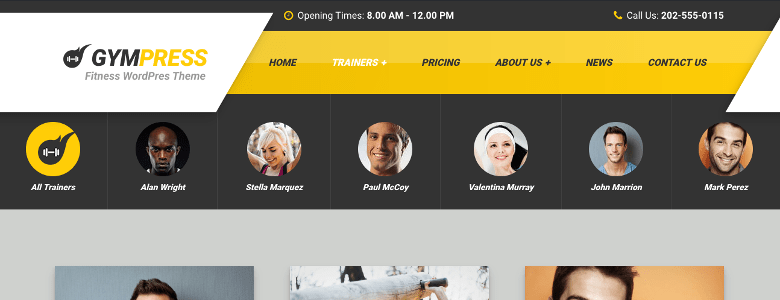
Adding special dropdown on your site is really simple. First, you will need to add featured images (recommended size is 90x90px) in each page you will like to link in the dropdown. In our case, we use single trainer pages.
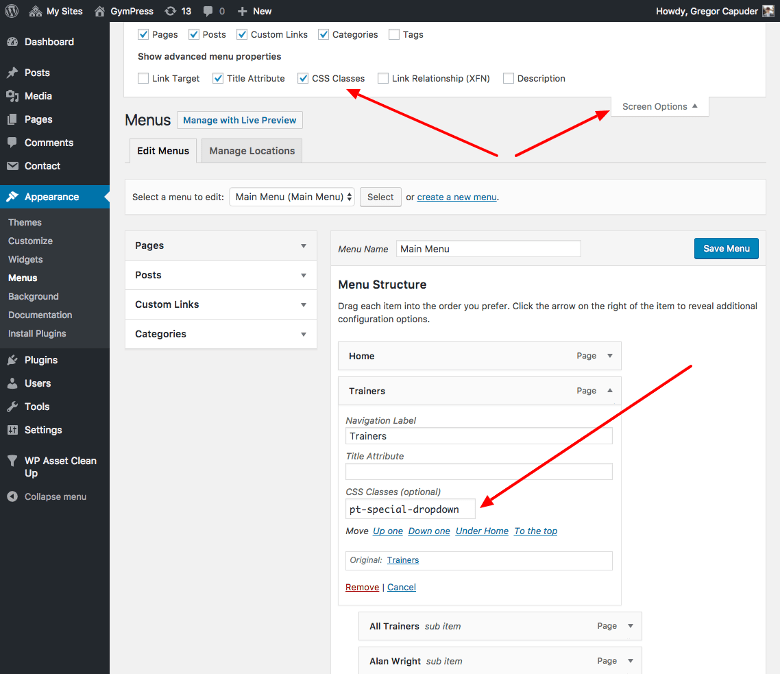
Once you got all the pages ready you will need to add pt-special-dropdown class in the parent link. If you don't see the field for CSS classes you will need to click on screen options at the top of the page and check CSS Classes checkbox.
Pages
wp-admin » Pages is the area where you will spend most of your time when building a site. We added a few tools in that process so you can create your pages easier and faster.
Page Templates
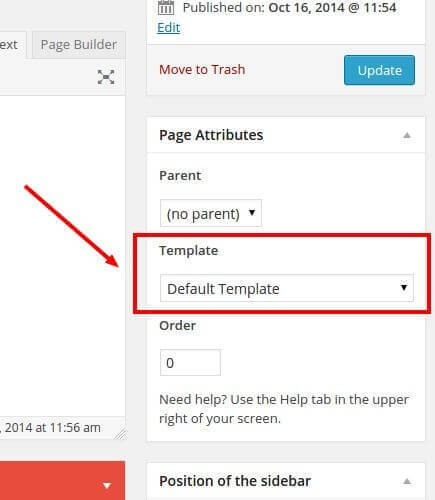
You can choose between 3 different Templates - Default Template, Front Page with Slider and Front Page With Layer/Revolution Slider.
Default Template: Just a default template for simple layouts and Page Builder. First you must choose the Page Builder option under the title and you are ready to go. You can add our widgets here, choose different visual styles and much more. More about that in the next chapter.
Front Page with Slider: This is a unique template which adds an option for a slider in the page options. It can be used with Page Builder. More about that in the Slider chapter.
Front Page with Layer/Revolution Slider: We don't include these two slider plugins with the theme but we make sure they work nicely, since we know our customers want to use them. When you activate this template there is a new Page Slider meta box in which you can put ID/alias from Layer/Revolution Slider.
Page Builder
Page Builder is a very powerful tool for making pages. Here is one example of how it looks:
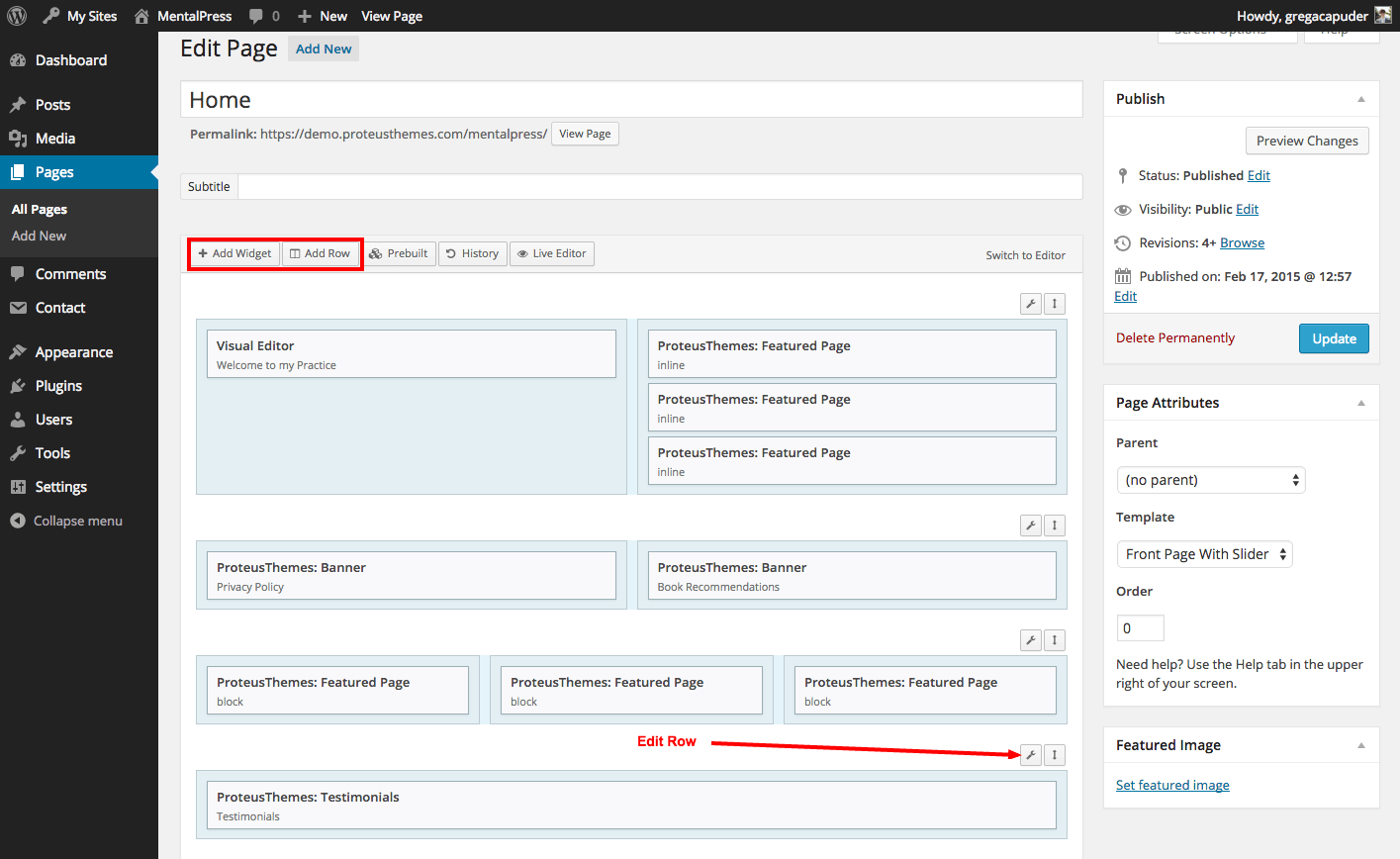
You can make any kind of grid with adding new rows and inside them you put widgets. When you are finished with adding widgets you can also move whole rows up and down.
For more information on how to use Page Builder please visit Page Builder by SiteOrigin documentation page.
You should also watch this great short video course: Page Builder Tips.
Page Builder Row Style
Let's take a look at how we can style Page Builder rows.
To start off we have to click on "Edit Row" for the row that we want to style as shown on the image above. An "Edit Row" window will open, and on the right, there are three setting tabs: Attributes, Layout and Design. Here you can customize different things for this particular row.
In the Layout tab you can set the Bottom Margin, Padding and change the Row Layout to Full Width. In the Design tab you can set the Background Color, Background Image and other things.
Page Builder Widgets
You can use almost any widget in the Page Builder. Let's take a look at a few not so straightforward ones.
SiteOrigin Editor Widget
SiteOrigin Editor will create for you the same editor environment as a normal WordPress editor does. You can use this widget if you want normal text editing options. The SiteOrigin Editor Widget is part of Site Origin Widgets Bundle.
Call to Action Widget
How do I add a button? With our custom shortcodes. You can find instructions in the Buttons section.
Featured Page Widget
Featured Page is a really simple widget that we use in Page Builder. All you have to do is to select the page and one of the two layouts we made for you.
But how do I change the image and text on the Front Page?
The image on the Front Page is just the normal Featured Image of the selected page. You can change that in the sidebar of every single page. Text can be changed in the Excerpt field which can be found at the end of the page settings. If the excerpt field is not there, you must click on the Screen Option (at the top of the page) and check Excerpt. For more info please take a look at the screenshot below.
MailChimp Subscribe
MailChimp Subscribe widget will help you collect emails from your potential clients, so you can email them a newsletter or a promotional offer and so increase your profits. Here is an example of the MailChimp subscribe widget (in the footer).
This widget is easy to setup. Just follow the instructions in the widget:
- Visit this URL and login with your mailchimp account,
- Create an API key and paste it in the MailChimp API key input field,
- Click on the Connect button, so that your existing MailChimp lists can be retrieved,
- Select which list you want your visitors to subscribe to, from the dropdown menu,
- Save the widget and update the page.
That's it! The subscribe form will be generated automatically (email field and a submit button) and you will be able to collect emails.
Slider
Building a Theme slider has never been easier.
You can create a Theme slider on any page you want. The only thing you must do is choose the page template Front Page With Slider (you can use this template even if it's not for the front page). After you select this page template there will be a new meta box at the bottom of the page which is called Front page slider. Now you can add images or videos to your slider.
When you add a video, you also have to upload a video "thumbnail", which will serve as a clickable area (also a play button overlay will be added to this image). When a user clicks on this image, the video will open in a pop-up modal window.
As you can see on the example image bellow, you also have the Slider settings tab. In Slider settings tab, you can change how the slider behaves and change the slider options.
This is how the slider backend looks like:
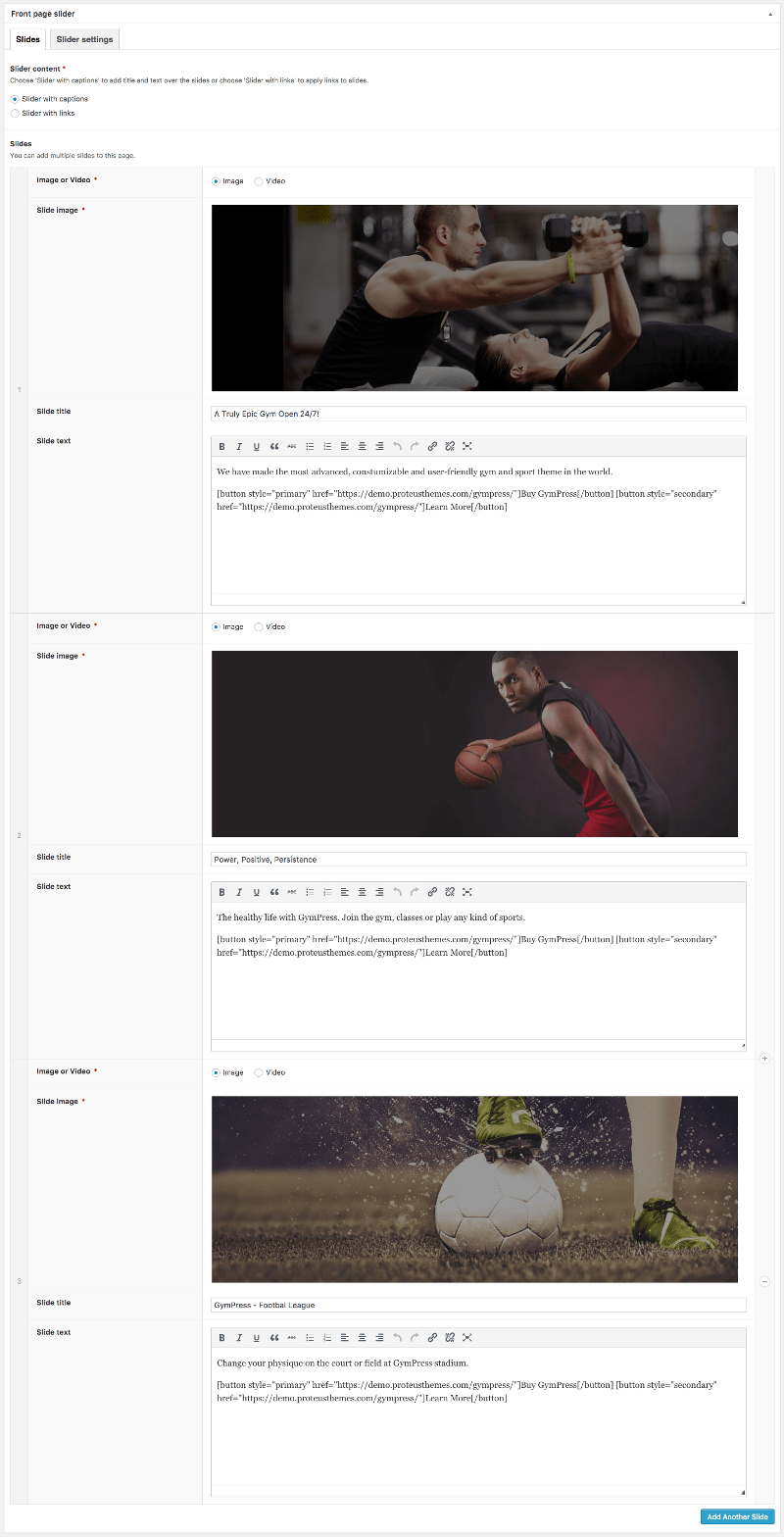
Please take a look at this slider dimensions article for the recommended size of the slider images for this theme.
ProteusThemes Options
You can find all Theme Options in the Customizer: Appearance » Customize. This is a live preview editor for your page.
Here you can change:
- Logo
- Header
- Navigation
- Sticky Menu
- Page Header Area
- Theme Layout & Colors
- Footer
- Custom Code
- And Much More ...
Shortcodes
Buttons
For adding buttons you must use the button shortcode which looks like this: [button]Your Text[/button]
There are 7 options with different attributes - style, href, target, fa, corners, fullwidth and class.
Text: You can change the text of the button.
Example: [button]New Text[/button]
Style: You can choose between a few styles - primary, secondary, danger, success, info or default.
Example: [button style="primary"]Your Text[/button]
Href: You can add URL to the button.
Example: [button href="https://www.proteusthemes.com"]Your Text[/button]
Target: You can choose if you want to open the link in the same - "_self" or new - "_blank" window.
Example: [button target="_blank"]Your Text[/button]
Font Awesome icon: You can add a font awesome icon to the button.
Example: [button fa="fa-phone"]Your Text[/button]
Full width: You can stretch your button to full width.
Example: [button fullwidth="true"]Your Text[/button]
Class: You can add extra custom classes to the button.
Example: [button class="btn-lg extra-custom-class"]Your Text[/button]
Icons - Font Awesome
Shortcode for Font Awesome is very similar to the buttons shortcode. It looks like this: [fa]
There are 3 options with different attributes - icon, href, target and color.
Icon: You can use any 519 FontAwesome icon. To set the selected icon, just get the title of the icon, for example "fa-phone".
Example: [fa icon="fa-phone"]
Href: You can add URL to the icon.
Example: [fa href="https://www.proteusthemes.com"]
Target: You can choose if you want to open the link in the same - "_self" or new - "_blank" window.
Example: [fa target="_blank"]
Color: You can set a custom color to your icon.
Example: [fa color="#ff00ff"]
So a Font Awesome icon shortcode with a home icon, linking to a page and opening in a new window/tab would look like this:
[fa icon="fa-home" href="https://www.proteusthemes.com" target="_blank"]
Plugins
We also use and support some of the best plugins for WordPress.
Required and Recommended Plugins
You can install and activate these plugins by going to wp-admin » Appearance » Install Plugins.
The list of required and recommended plugins used in this theme:
- Advanced Custom Fields
- ACF Repeater Field (bundled)
- ProteusThemes Shortcodes
- Page Builder by SiteOrigin
- SiteOrigin Widgets Bundle
- One Click Demo Import
- Contact Form 7
- WP Featherlight
- Breadcrumb NavXT
- Custom Sidebars by ProteusThemes
Contact Form 7
We use Contact Form 7 for our Contact Us page. This is the code from our demo:
<div class="row">
<div class="col-xs-12 col-lg-4">
[text* your-name class:form-control placeholder "First Name*"]
</div>
<div class="col-xs-12 col-lg-4">
[text* your-last-name class:form-control placeholder "Last Name"]
</div>
<div class="col-xs-12 col-lg-4">
[email* your-email class:form-control placeholder "E-mail*"]
</div>
<div class="col-xs-12">
[textarea your-message class:form-control placeholder "Message"][submit class:btn class:btn-primary "Send Message"]
</div>
</div>
After that just place the plugin's shortcode into your Contact Us page.
WooCommerce
This theme supports basic WooCommerce integration.
Once WooCommerce is activated you will see this notice:

Click on Run the Setup Wizard button to begin the WooCommerce install. That will start the setup wizard, where you can set things like shop pages, store locale, shipping & tax and payments.
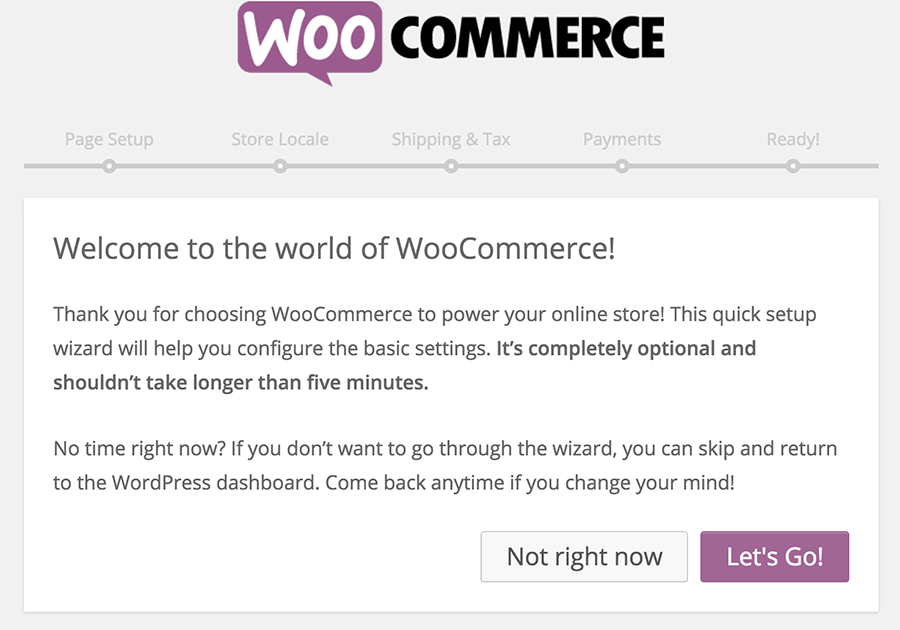
If you want to change some settings, you can change them in WooCommerce » Settings. There are many tabs at the top, you can configure to fit your needs.
Most of our themes come with our own demo products for the WooCommerce store and will be imported automatically when you import the demo content using our industry-leading One Click Demo Import plugin. You need to make sure that WooCommerce is activated at the time that you import the demo data.
However, you can (optionally) install the additional demo products by WooCommerce. Go to Tools » Import » WordPress and import the demo XML file which can be found in the folder where WooCommerce was installed on your server. Usually this is in wp-content/plugins/woocommerce/dummy-data/dummy-data.xml. Also check the Download and import file attachments checkbox, so that all product images will be downloaded as well.
When you're done, you should see the products:
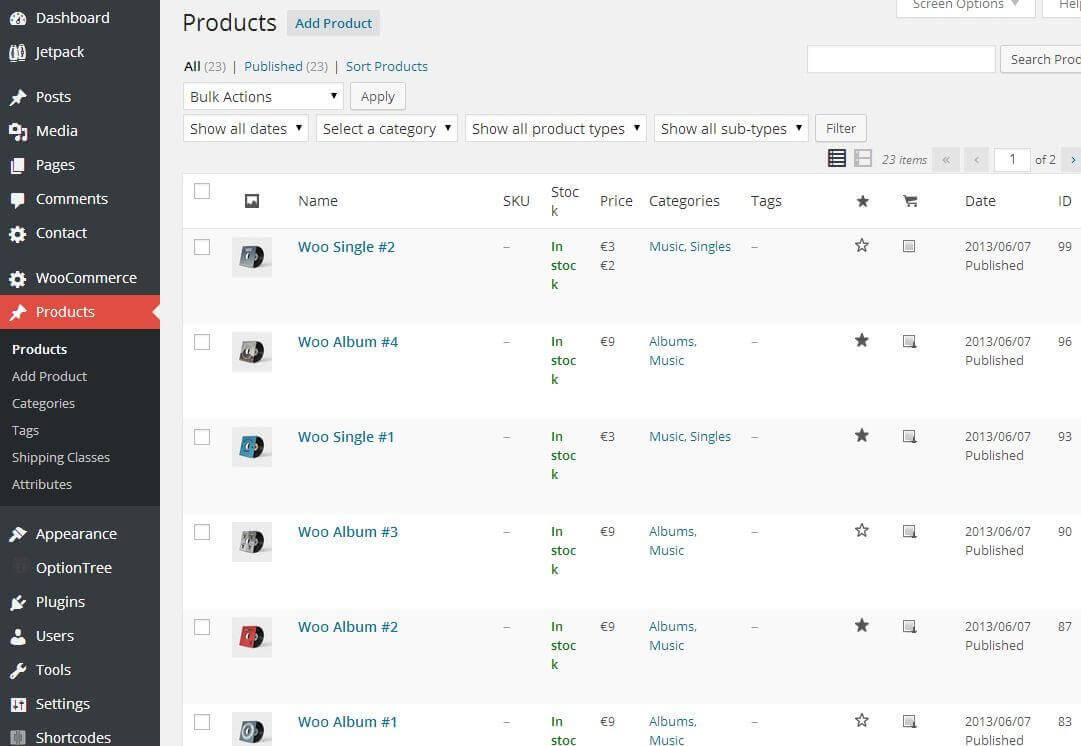
When you are done with the settings, go to Appearance » Widgets.
Drag & Drop the WooCommerce widgets that start with "WooCommerce" to the sidebar called Shop Sidebar.
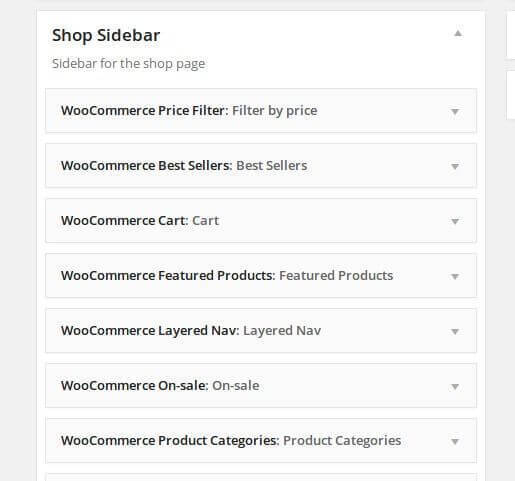
That's all, your WooCommerce shop is now ready!
Breadcrumbs NavXT
The breadcrumbs in this theme are powered by the Breadcrumbs NavXT plugin.
All the settings for breadcrumbs can be found in Settings » Breadcrumbs NavXT. When you first access this settings page, there might be a notice, which has a link Migrate now at the end, just click it and it will take you to the correct settings page. Here you can define a separator (which should be empty by default for our themes), breadcrumb hierarchies for different pages (pages, custom post types, taxonomy, ...) and set other breadcrumbs related things.
Default Product Breadcrumbs
Let's take a look at how to setup the default breadcrumbs used on this theme for the Products custom post type. Go to Settings » Breadcrumbs NavXT and click on the Post Types tab. Scroll down to the Product section, and set the Product Root Page to Shop page and since we set the root page, we can also disable (uncheck) the Product Archive Display checkbox. Don't forget to save the settings.
Footer
Last but not least there is our footer area. The footer area is divided into:
Footer Widgets
Footer Widgets is the place where you can add the last things to your page. You can add widgets in the Apperance » Widgets » Footer. There are also few options for that area in Appearance » Customize » Theme Options » Footer. You can changes different colors there.
Bottom Footer
The Bottom Footer area is the place for copyrights or some custom text. Custom text for the left and right side of the bottom footer can be added in live customizer Appearance » Customize » Theme Options » Footer.
Translations
Manual translation
We have an article with a video on how to translate our themes.
WPML for Multilingual sites
This theme officially supports WPML. Head over to the WPML website, buy the subscription, then install the main plugin — likely the OTGS Installer Plugin. When prompted to download, install, and activate specific WPML plugins, make sure to install and activate these:
- WPML Multilingual CMS
- String Translation
- Media Translation
WPML’s setup wizard will also prompt you to install other plugins if it thinks you need them. For example, if this theme includes a WooCommerce-based site, WPML will prompt you to install WooCommerce Multilingual & Multicurrency. Install whatever WPML suggests installing.
Extras
Demo Images
All images used in GymPress WP can be found on Shutterstock.
Customizations
If you need advanced customizations for this theme, we can do that. See our Theme Customization page for details.
Changelog
View the GymPress WP changelog.
Support
If you need more help after all, you can write to us.

